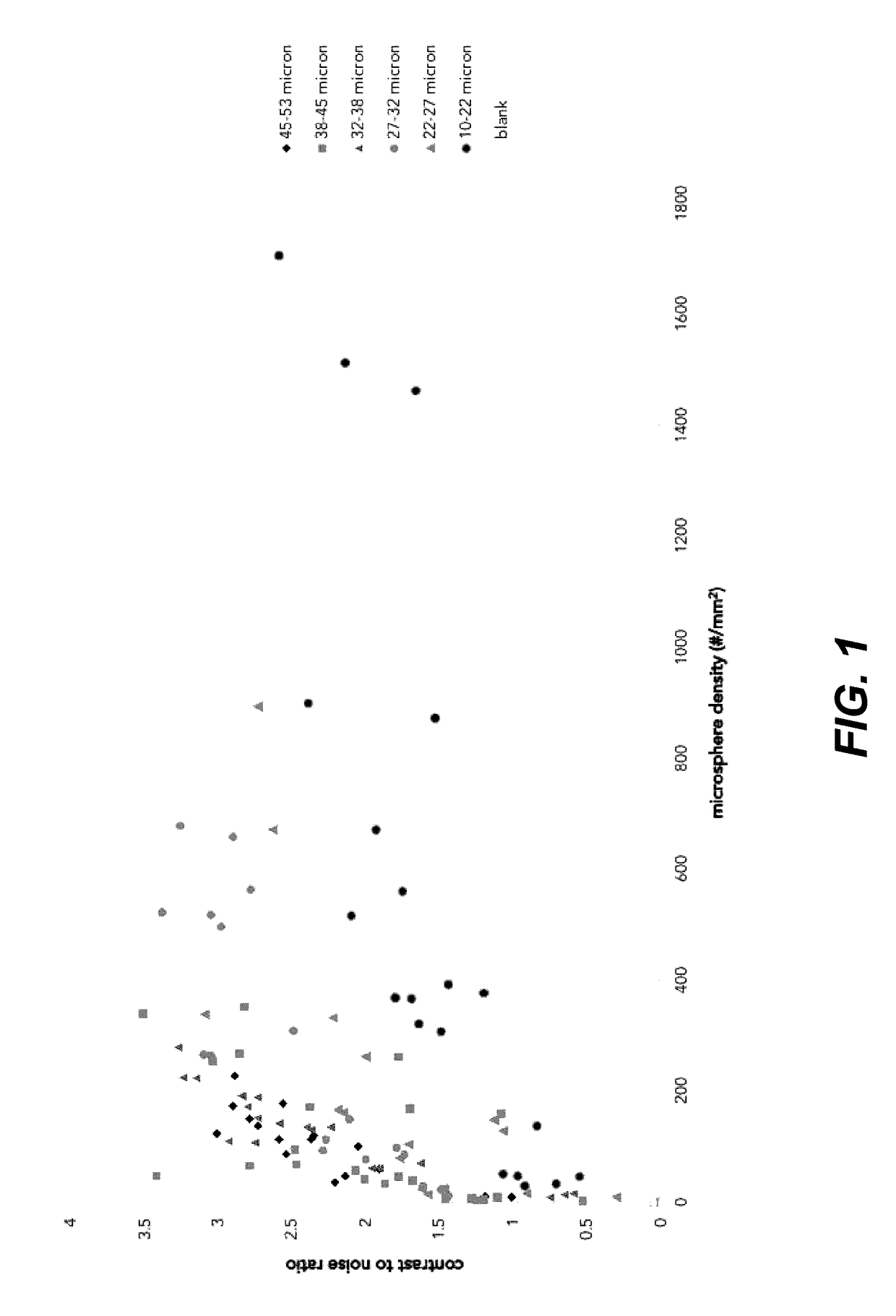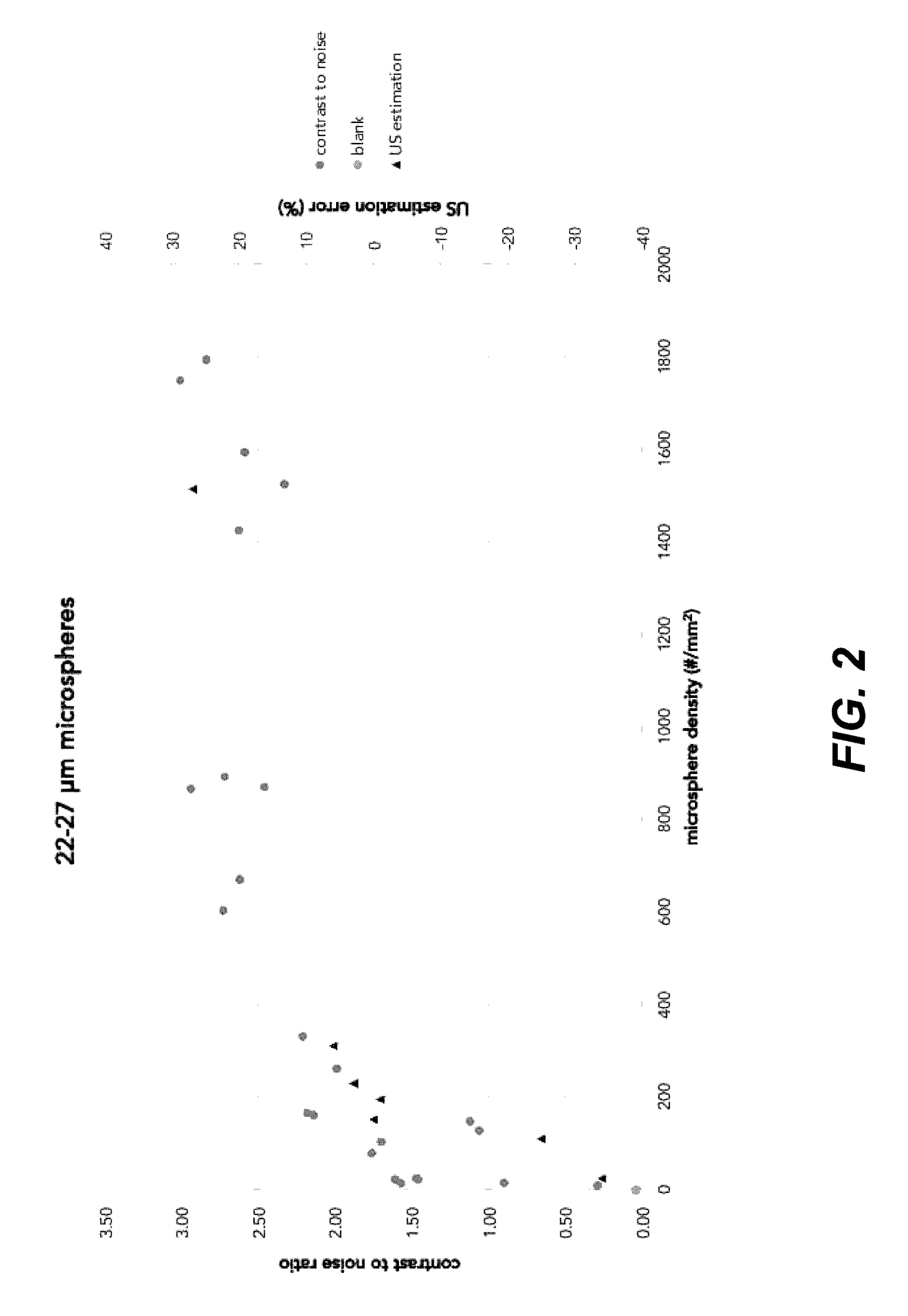Medical devices with coatings for enhanced echogenicity
a technology of enhanced echogenicity and medical devices, applied in the field of medicine, physics and biotechnology, can solve the problems of increasing scattering, better visibility of medical objects, and decreasing the visibility of objects, and achieve the effect of best visible objects
- Summary
- Abstract
- Description
- Claims
- Application Information
AI Technical Summary
Benefits of technology
Problems solved by technology
Method used
Image
Examples
example 1
[0091]Commercially available solid glass microspheres (from Cospheric) with diameters ranging from 10 to 22 μm, 22 to 27 μm, 27 to 32 μm, 32 to 38 μm, 38 to 45 μm and 45 to 53 μm, all with a density of 2.5 g / mL, were mixed through a polyurethane coating matrix. The microspheres were added in different amounts in order to prepare mixtures containing 0.5 to 75.0 vol. % microspheres in the coating matrix. Subsequently, either 30- or 60-μm thick coating films were drawn on both glass and PEBAX® 6233 slides as substrates using a film applicator. The density of microspheres was determined to vary from 2 to 1831 particles / mm2.
[0092]The coated substrates were measured by ultrasound using a 33 mm linear array probe operating in brightness-mode (B-mode) at 6 MHz. The substrates were placed under an approximate angle of 45 degrees inside a commercially available ultrasound phantom, which acted as the medium.
[0093]From the recorded images, the contrast-to-noise ratio (CNR) was determined by com...
example 2
[0102]Commercially available solid glass microspheres with diameters ranging from 10 to 22 μm, 22 to 27 μm, 27 to 32 μm, 32 to 38 μm, 38 to 45 μm and 45 to 53 μm, all with a density of 2.5 g / mL, were mixed through a polyurethane coating matrix. The microspheres were added in different amounts in order to prepare mixtures containing 1.0 to 75.0 vol. % microspheres in the coating matrix. Subsequently, either 30- or 60-μm thick marker bands of coating were drawn on glass slides using a film applicator. These marker bands were applied by masking the area that was required to be uncoated. The width of the marker bands was measured.
[0103]The coated substrates were measured by ultrasound using a 33 mm linear array probe operating in brightness-mode (B-mode) at 6 MHz. The substrates were placed under an approximate angle of 45 degrees inside a commercially available ultrasound phantom, which acted as the medium.
[0104]From the recorded images, the width of the marker bands as visible under u...
example 3
[0116]Solid glass microspheres with a diameter ranging from 38 to 45 μm, as described above, with a density of 2.5 g / mL, were mixed through a polyurethane coating matrix. Subsequently, glass slides and plastic (PEBAX® 6233) were coated with these particles in different densities. The coated substrates were measured by ultrasound using a 33-mm linear array probe operating in brightness-mode (B-mode) at 6 MHz. The substrates were placed under an approximate angle of 45 degrees inside a commercially available ultrasound phantom, which acted as the medium. From the recorded images, the contrast-to-noise ratio (CNR) was determined in the same way as described in Example 1, and the determined CNRs were plotted against the microsphere concentration (FIG. 7).
[0117]As can be seen in FIG. 7, the CNR values for glass and plastic coated with the same amount of particles are comparable. This demonstrates that the material of the used surfaces does not significantly affect the CNRs.
PUM
| Property | Measurement | Unit |
|---|---|---|
| diameter | aaaaa | aaaaa |
| diameter | aaaaa | aaaaa |
| diameter | aaaaa | aaaaa |
Abstract
Description
Claims
Application Information
 Login to View More
Login to View More - R&D
- Intellectual Property
- Life Sciences
- Materials
- Tech Scout
- Unparalleled Data Quality
- Higher Quality Content
- 60% Fewer Hallucinations
Browse by: Latest US Patents, China's latest patents, Technical Efficacy Thesaurus, Application Domain, Technology Topic, Popular Technical Reports.
© 2025 PatSnap. All rights reserved.Legal|Privacy policy|Modern Slavery Act Transparency Statement|Sitemap|About US| Contact US: help@patsnap.com



